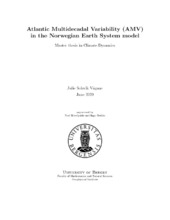Atlantic Multidecadal Variability (AMV) in the Norwegian Earth System model
Master thesis
Permanent lenke
https://hdl.handle.net/1956/22970Utgivelsesdato
2020-06-26Metadata
Vis full innførselSamlinger
- Master theses [123]
Sammendrag
The causes of low-frequency sea surface temperature (SST) variations in the Atlantic, known as Atlantic Multidecadal Variability (AMV), are debated. AMV has climatic impacts on for instance hurricane activity and Sahel rainfall, and understanding AMV can improve decadal predictions. While some discuss whether AMV arises due to external forcing, the ocean dynamics or the thermodynamic atmosphere-ocean interaction, others question the very existence of AMV. In this thesis, I look at the Norwegian Earth System Model (NorESM), investigating low-frequency variability and possible drivers for AMV in the North Atlantic. I compute a heat budget and a multiple linear regression (MLR) model, and investigate the influence of the dynamics and thermodynamics on AMV on different time scales and regions. I use the North Atlantic Oscillation (NAO) and the Atlantic Meridional Overturning circulation (AMOC) to characterize the large-scale impacts associated with ocean and atmospheric circulation patterns. The MLR model with NAO and AMOC, manages to explain 20.5 % of the temperature tendency on an interannual time scale, and 34.8 % on a decadal time scale in the subpolar gyre (SPG). In the tropics, the variance explained is smaller, only explaining 6.5 % interannually and 9.6 % decadally. Through a comparison with observations, I found that the AMOC amplitude is underestimated and the SST is off by over 1C. This may influence the performance of the MLR model. Finally, I present some ideas for improving the MLR model and the possibility for decadal predictions.
